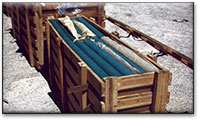|
| |

Intercepted Iraqi aluminum tubes used for uranium enrichment.
|
Recently the press has devoted much coverage to the Bush administration’s use of faulty intelligence in making its case for war against Iraq. One particular case shows that the administration knowingly disregarded scientific analysis of intelligence data that contradicted its case.
In the weeks leading up to the war, senior administration officials repeatedly stated that Iraq had attempted to acquire more than 100,000 highstrength aluminum tubes for gas centrifuges to be used for enriching uranium. Highly enriched uranium is one of the two materials that can be used to make nuclear weapons.
This claim was made by National Security Adviser Condoleeza Rice, Vice President Dick Cheney, and finally by President Bush on September 12, 2002, in his address to the United Nations (UN) General Assembly. The president repeated this claim on several occasions, including his State of the Union address to Congress in January 2003. The contention was also featured in Secretary of State Colin Powell’s speech to the UN Security Council on February 5, 2003, regarding Iraq’s weapons of mass destruction.57
The question before the intelligence community was whether these tubes, which in fact never reached Iraq because of a successful U.S. intervention, were meant to be used for centrifuges or for another purpose: motor casings for short-range rockets. The Central Intelligence Agency (CIA) advocated the view that the tubes were intended for centrifuges, and argued that the tight tolerances on the tubes’ dimensions and finish could have no other interpretation. However, a set of technical experts from the Department of Energy’s (DOE) Oak Ridge, Livermore, and Los Alamos National Laboratories reviewed the CIA analysis and disagreed with this interpretation because the tube dimensions were far from ideal for this purpose. In fact, the dimensions and the aluminum alloy were identical to those of tubes acquired for rockets by Iraq in the 1980s. Furthermore, the Iraqis had developed and tested centrifuges before the first Gulf War that were much more capable than those that could have been built with the imported tubes. The DOE experts also pointed out that if these tubes were actually intended for centrifuges, there should be evidence of attempts by the Iraqis to acquire hundreds of thousands of other very specific components, but no such evidence existed. This critique of the CIA interpretation was seconded by the State Department’s intelligence branch and, independently, by an international group of centrifuge experts advising the International Atomic Energy Agency (IAEA).58
The claim that the aluminum tubes were intended for the manufacture of uranium for nuclear weapons was central to Secretary Powell’s case to the UN that Iraq had a nuclear weapons program. He had been briefed by the IAEA about its disagreement with the CIA analysis, and was aware of a controversy inside the U.S. government about the administration’s claim because the DOE and State Department had both commented on the draft of his speech, which even mentioned that there was disagreement among experts. However, Powell’s speech dismissed this disagreement by lumping the U.S. experts with the Iraqis: “Other experts, and the Iraqis themselves, argue that they are really to produce the rocket bodies for a conventional weapon, a multiple rocket launcher.”59 Many experts, especially at the DOE, felt “that was really a slap in the face...my friends in DOE felt shocked...we were thrown in the same camp as the Iraqis.”60
As Dr. David Albright, a weapons expert and president of the Institute for Science and International Security in Washington, DC, has noted, “It bespeaks something seriously wrong that a proper technical adjudication of this matter was never conducted. There was certainly plenty of time to accomplish it.”61
57 D. Albright, “Iraq’s Aluminum Tubes: Separating Fact from Fiction,” December 5, 2003. Online at www.isis-online.org; B. Gellman, “Search in Iraq Fails to Find www.isis-online.org; B. Gellman, “Search in Iraq Fails to Find www.isis-online.org Nuclear Threat,” Washington Post, October 26, 2003; J. Cirincione, J. Mathews, and G. Perkovich, “WMD in Iraq: Evidence and Implications,” Carnegie Endowment for International Peace, January 2004. Online at wmd.ceip.matrixgroup.net/iraq3fulltext.pdf
58 Ibid.
59 Ibid.
60 Four Corners, Australian Broadcasting Corp., October 27, 2003. Online at www.abc.net.au.
61 Author interview with David Albright, January 2004.
< Previous Next >
|

